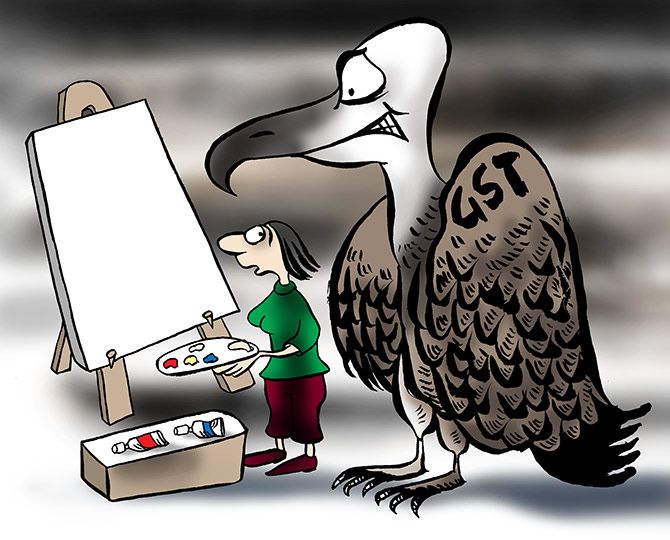'At a recent event, says Kishore Singh, almost everyone present lamented art being labelled as 'goods', and therefore the artist its 'manufacturer'.
Illustration: Uttam Ghosh/Rediff.com

Over recent weeks, worried emails have been flying back and forth between and from artists in New Delhi and Mumbai as they grapple with the complexities of the Goods and Services Tax.
If before its announcement it was the likely rate of tax that had them worried, now it is its implementation that is giving them sleepless nights.
GST, by their reckoning, is anything but simple and has added to their load of paperwork.
At a recent party, almost everyone present lamented art being labelled as 'goods', and therefore the artist its 'manufacturer'.
This was the point made by artist Jogen Chowdhury who, in his letter to the chairman of the GST Council, lamented that artists were kept out of a category that included dancers, musicians and sportspersons outside the purview of GST.
'An artwork is not an industrial product or a consumable good. It is an intellectual property created individually by an artist,' he wrote.
Noting that works like painting, drawing or sculpture 'solely depend on an individual artist's talent and hard work', he made a plea for exemption to 'give some dignity to the artists and painters of India by not putting them in the category of producers of regular mercantile goods'.
Chowdhury makes a valid point, especially since an artist needs several decades to establish a career, and that the market is dominated by those who are dead and, therefore, out of the ambit of GST (which, of course, galleries must still pay).
Nor is the level of taxation itself the subject here, but its implementation which, if unaddressed, might lead to some capriciousness.
Take, for instance, the notion that any movement from an artist's studio to any place outside denotes a sale.
The most obvious case is of an artist's work being sent for an exhibition, say from New Delhi to Mumbai.
At the first instance the artist will have to pay tax on its declared value at the point of origin. But no one knows how many works will actually sell, how many works the exhibitor or gallery will retain for potential possible sale, at what discounted rate these will actually trade, thereby creating a mountain of paperwork and a lack of transparency.
Since an artist's works are exhibited continuously in different shows in different locations, this implies a similar trail being established for works consigned to, say, Hyderabad, or Bengaluru, Hong Kong or London, in any given month.
It requires someone constantly monitoring the paperwork. "And what happens should our works be damaged en route?" an artist asked me. There are no answers.
Artists consign works to galleries where they are kept over long periods in hope of sales, sometimes for years.
But the GST Council has capped this period at six months, after which the entire unsold gallery stock will be taxed.
For high-value works, for those consigned to travelling exhibitions over extended periods of time, and for emerging artists whose reputations need to be built through constant exhibitions as a reminder of their talent and presence, this seems difficult.
In a sense, it is a tax ahead of any sale and, even, possibly, no sale.
True, the system has just been introduced and some anomalies may be done away with, provided the government is looking at this sector that is financially minuscule but has a soft power and reach that is monumental.
Artists readily and often donate works to charities and for fundraising, they are usually among the more honest tax payers within the Indian system, and feel that the current system amounts to harassment and persecution.
Their request: Someone in the government should lend them an ear.
Kishore Singh is a Delhi-based writer and art critic. These views are personal and do not reflect those of the organisation with which he is associated.












 © 2025
© 2025